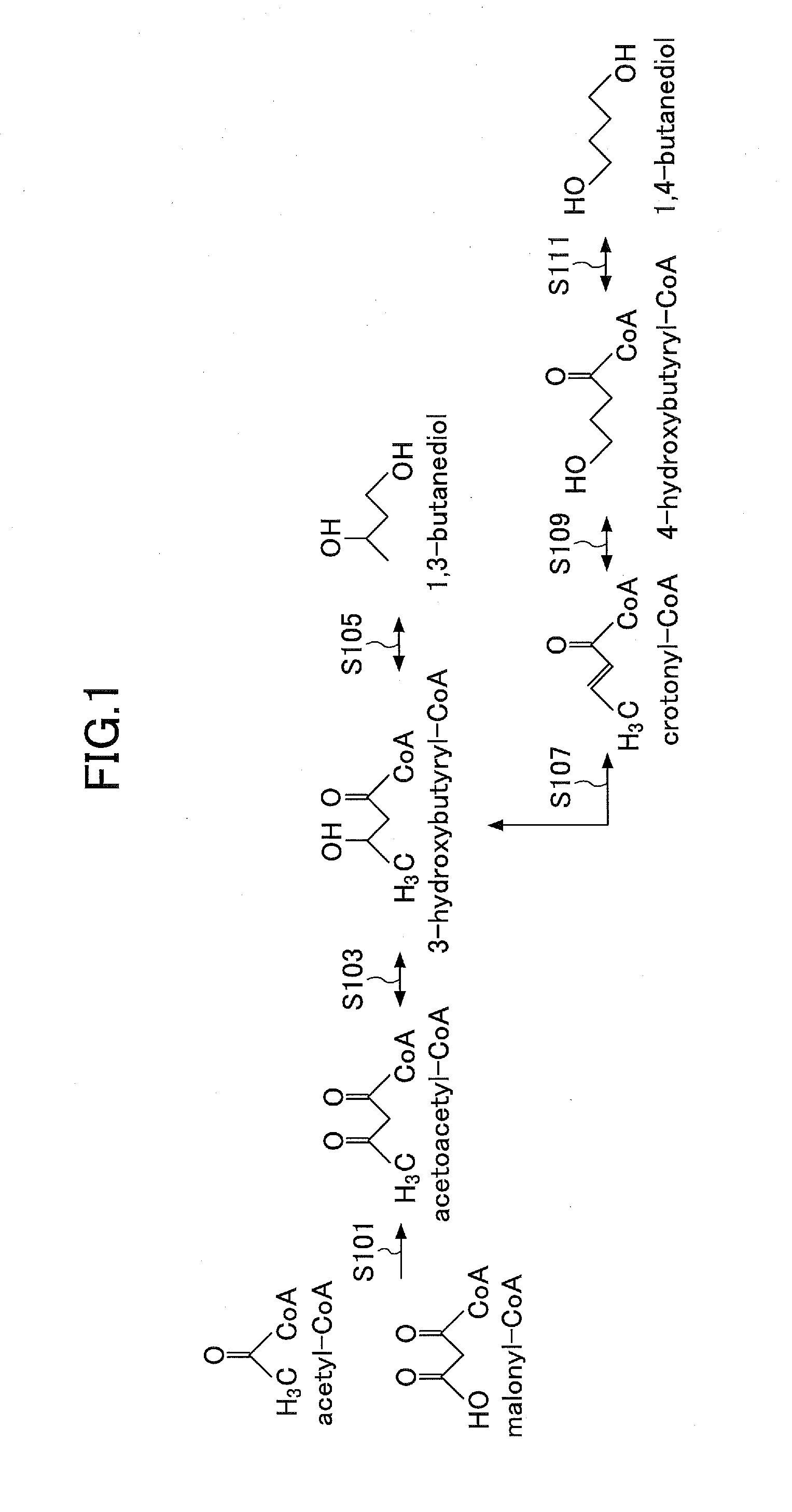Manufacturing method for a butanediol
a technology of butanediol and manufacturing method, which is applied in the direction of lyase, transferase, enzymology, etc., can solve the problems of complex processes of methods described in patent documents 1 to 3 and non-patent documents 1 and 2
- Summary
- Abstract
- Description
- Claims
- Application Information
AI Technical Summary
Benefits of technology
Problems solved by technology
Method used
Image
Examples
example 1
Practical Example 1
[0077]A blunt end fragment of a gene sequence indicated by sequence number 3 (that corresponded to aldehyde reductase) was totally synthesized to add CAT (that corresponded to a restriction enzyme NdeI site in combination with an initiation codon) to a 5′-end and GAGCTC (that corresponded to an SacI site) to a 3′-end by an ordinary method and inserted into an SmaI site in multi-cloning sites of pUC18 to obtain a plasmid. An obtained plasmid was treated with a restriction enzyme to obtain a NdeI-SacI fragment that contained a region of sequence 3. Such a gene fragment was inserted into a NdeI-SacI site in multi-cloning sites of an expression vector pET17b (produced by Novagen, Inc.) by an ordinary method to obtain pETBD3.
[0078]A blunt end fragment of a gene sequence indicated by sequence number 1 (that corresponded to catoacetyl-CoA synthase) was totally synthesized by an ordinary method and inserted into an SmaI site in multi-cloning sites of pUC18 to obtain a pla...
example 2
Practical Example 2
[0083]A blunt end fragment of a gene sequence indicated by sequence number 4 (that corresponded to alcohol / aldehyde reductase) was totally synthesized by an ordinary method and inserted into an SmaI site in multi-cloning sites of pUC18 to obtain a plasmid. A blunt end fragment was prepared by PCR in such a manner that 15 bp at each of an upstream side and a downstream side of a part of pETBD312 prepared by a method similar to that of Practical Example 1 which part corresponded to sequence number 3 were added to an obtained plasmid as a template.
[0084]A straight-chain blunt fragment was prepared in such a manner that sequence 3 was eliminated from pETBD312, by inverse PCR that used a primer that anneals outward from an upstream side or a downstream side of a part of pETBD312 prepared by a method similar to that of Practical Example 1 which part corresponded to sequence number 3.
[0085]Two obtained blunt end fragments were coupled by In-Fusion HD Cloning Kit to prepa...
example 3
Practical Example 3
[0087]A blunt end fragment of a gene sequence indicated by sequence number 5 (that corresponded to a DtsRI subunit of acetyl-CoA carboxylase) was totally synthesized by an ordinary method and inserted into an SmaI site in multi-cloning sites of pUC18 to obtain a plasmid. A sequence that corresponded to each of 15 bp at an upstream side and 15 bp at a downstream side that contained “TA” in an NdeI site of multi-cloning sites of pRSFDuet (produced by Novagen, Inc.) in addition to 15 bp at each of a 5′-end and a 3′-end of sequence 4 was added to an obtained plasmid as a template to prepare a primer with 30 bp at each of both ends, and an amplification reaction was executed to obtain a blunt end fragment that contained sequence 5. Ligation of an obtained blunt end fragment and a straight-chain fragment obtained by applying a restriction enzyme treatment with restriction enzyme NdeI to pRSFDuet was executed by In-Fusion. HD Cloning Kit to obtain pRSBD05 that contained ...
PUM
| Property | Measurement | Unit |
|---|---|---|
| temperature | aaaaa | aaaaa |
| temperature | aaaaa | aaaaa |
| temperature | aaaaa | aaaaa |
Abstract
Description
Claims
Application Information
 Login to View More
Login to View More - R&D
- Intellectual Property
- Life Sciences
- Materials
- Tech Scout
- Unparalleled Data Quality
- Higher Quality Content
- 60% Fewer Hallucinations
Browse by: Latest US Patents, China's latest patents, Technical Efficacy Thesaurus, Application Domain, Technology Topic, Popular Technical Reports.
© 2025 PatSnap. All rights reserved.Legal|Privacy policy|Modern Slavery Act Transparency Statement|Sitemap|About US| Contact US: help@patsnap.com

